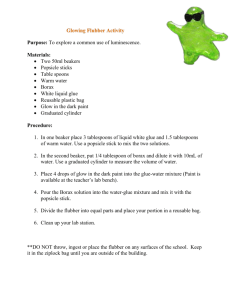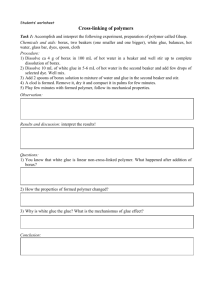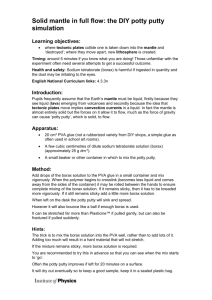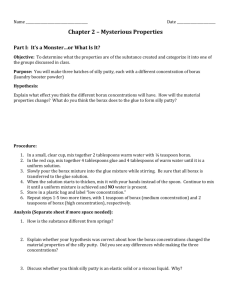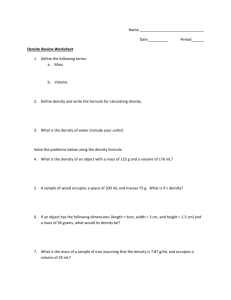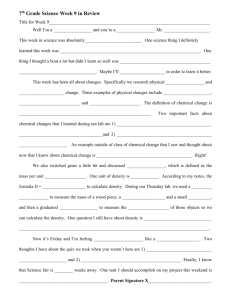Variables Subject Area(s): Associated Unit:
advertisement
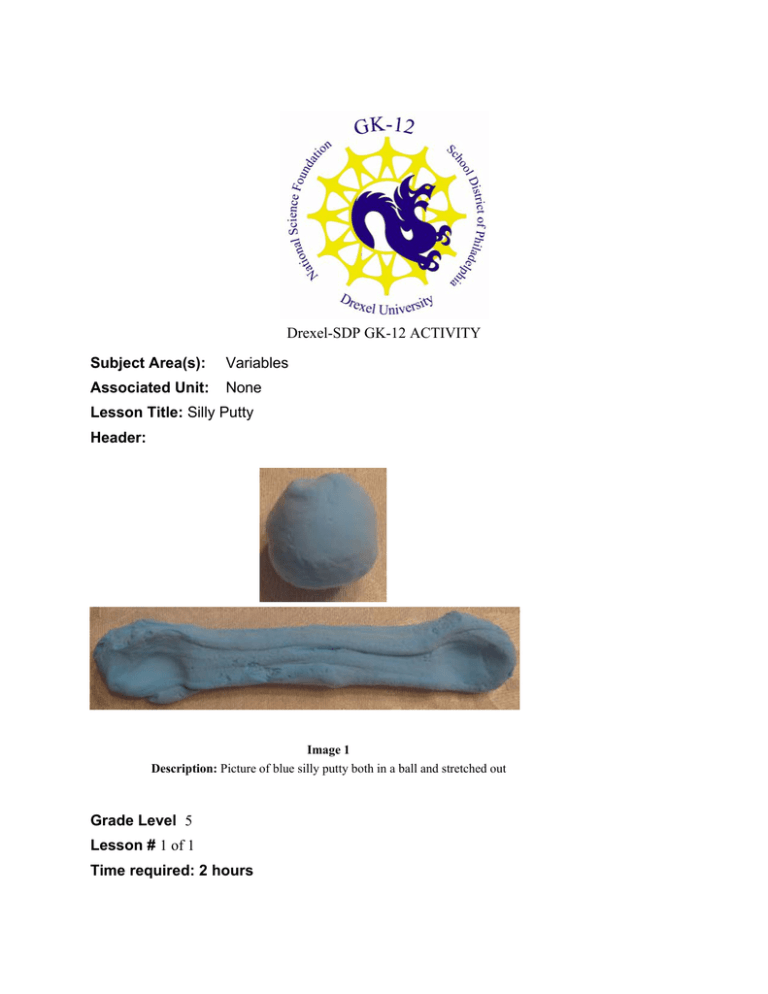
Drexel-SDP GK-12 ACTIVITY Subject Area(s): Variables Associated Unit: None Lesson Title: Silly Putty Header: Image 1 Description: Picture of blue silly putty both in a ball and stretched out Grade Level 5 Lesson # 1 of 1 Time required: 2 hours Summary Students will take on the role of materials engineers and use their knowledge of variables to optimize a recipe for silly putty that will both bounce the highest and stretch the most. Engineering Connection Material engineers have to be able to create materials that meet certain criteria. A lot of times, when several characteristics must be met, making the material meet one characteristic will cause it to no longer meet the others. Therefore, there must be a balance in order to successfully meet all of the required criteria. In order to meet the suggested criteria, engineers can simply vary the parameters and test the results. This is more of a trial and error type of problem solving, but one which the students will use to solve a specific problem. Keywords Silly Putty, Control Variable, Independent Variable, Dependent Variable, Materials Engineering Educational Standards • Science: 3.1.7, 3.2.7, 3.4.7, 3.7.7 • Math: Calculating means and averages, Graphing Pre-Requisite Knowledge Learning Objectives After this lesson, students should be able to: • Understand the type of tasks that materials engineers may be asked to complete • Understand how manipulating variables in a controlled experiment can be used to solve this task • Know how to analyze their results Introduction / Motivation Start by giving out the “silly putty handout” and reading it over with the students. Go over with them that they are working as materials engineers for this lesson and that they have a job to do. If they are successful than they may be rewarded with a promotion, a bonus, or simply, job retention. However, if they are unsuccessful, then they run the risk of losing their job. Explain to them what exactly a materials engineer is. Then go over with them the procedure to make silly putty and have them identify all the potential variables. Once the variables are identified, label each variable as either a control variable, a dependent variable, or an independent variable. 2 Lesson Background & Concepts for Teachers Polyvinyl acetate + Cross-linker → Silly Putty (Elmer’s Glue) (Borax) Dependent Variable Variables: Control – Method, Water, Glue Independent – Borax Dependent – Bounce Height, Stretch Distance Independent Variable Variables Method - Control Amount of water - Control Amount of glue - Control Amount of Borax - Independent Bounce height - Dependent Stretch distance – Dependent Other information 1 Tablespoon = 3 Teaspoons Also, when everything is mixed, notice that the baggie gets hot. This is an exothermic reaction. Vocabulary / Definitions Word Definition Variables Things that are likely to vary Control Variables that are kept constant variable Dependent Variable that we measure variable Independent Variable that we change variable Crosslinks Covalent bonds linking one polymer chain to another 3 Materials - Tap water Borax Elmer’s glue (different types of Elmer’s glue work better than others (i.e. school glue, allpurpose glue), this can be another experiment) Measuring spoons (plastic food spoons are fine as long as you figure out the spoon volume in tea or table spoons and adjust accordingly) Ziploc baggies Yard or meter stick Gloves (optional) Food coloring (optional) Pre-Activity Preparation - Split everything up (i.e. borax, glue, water) so that it is easy to hand out - Go over the procedure with the students before handing anything out, or before splitting into groups. Make sure the students can repeat the procedure back to you before beginning. With the Students 1. Listed below is the suggested fabrication method: Fabrication Method 1. Add 3 tablespoons of water into a plastic bag 2. Add 2 tablespoons of Elmer’s glue into the plastic bag and mix 3. Add x amount of Borax into the bag and mix 4. Remove the material from the bag and dry by rolling in your hands 2. Because the amount of Borax is the independent variable, each group will be assigned one or two (depending on the time) amounts of Borax to add. (I suggest that the amount of Borax is somewhere in the range of 3-15 TEAspoons) (3 teaspoons = 1 tablespoon) 3. Make sure the students know the difference between teaspoons and tablespoons. 4. Make a table on the board with the following columns: Group #, Borax amount, Bounce height (4 columns), Stretch distance (4 columns). Have the students copy this into their notebooks. 5. Hand out the materials and let the students start mixing. 6. Try to ensure that each group dries the silly putty by rolling it in their hand for the same amount of time (about 5 minutes). 7. Use a yard stick to test both bounce height and stretch height. a. When dropping, drop from the same height and ensure that the silly putty is rolled in a ball (repeat this three times). Suggest doing the bounce height first b. When stretching, just be consistent with how the measurements are performed (repeat this three times) 4 8. Have the students record the results and average both the bounce height and stretch distance values. 9. Hand-out graph paper and go over with the students how to graph both bounce height vs. borax amount and stretch distance vs. borax amount. Post-Activity Assessment Go over with the students the graphs of their results and see if they can come up with an optimal recipe. Lesson Closure Investigating Questions - What could we change to improve upon the experiment? - How well was out experiment controlled? - What other variables were introduced and how could better control them? Lesson Extensions - Look at how different types of glue effects bounce height and stretch distance - Bring in store bought silly putty and compared the optimized recipe made silly putty with the store bought silly putty - Chemical engineers frequently have to scale-up a fabrication procedure to make larger amounts of a product. How could we take the recipe as it is now (listed in terms of teaspoons and tablespoons) and change everything to ratios? For example, if we used 5 gallons of glue, then how much borax and water should we use? References Owner Drexel University GK-12 Program Contributors Jason Coleman Copyright Copyright 2008 Drexel University GK-12 Program. Reproduction permission is granted for nonprofit educational use. 5 Silly Putty Procedure: You are a materials engineer working for a start up chemical company called Polymix. Through a top secret agreement with the government, Polymix has been requested to make a material that can both bounce and stretch. Preliminary research has shown that Elmer’s glue and Borax can be used to produce the desired material. Preliminary research has also designated a preferred manufacturing method. It is your job to determine the best ratio of Elmer’s glue and Borax that provides a material that will bounce the highest and stretch the farthest. Manufacturing Method 5. Add 3 tablespoons of water into a plastic bag 6. Add 2 tablespoons of Elmer’s glue into the plastic bag and mix 7. Add x amount of Borax into the bag and mix 8. Remove the material from the bag and dry by rolling in your hands Vocabulary Variable – something that may vary or change over the course of the experiment Control Variable – a variable that is not changed or held constant Independent Variable – variable that we change Dependent Variable – variable that we observe and/or measure Variables Method Amount of water Amount of glue Amount of Borax Bounce height Stretch distance Look at each of the variables above and identify whether it is a controlled variable, independent variable, or a dependent variable. Can you think of any other variables that were not properly controlled? Other information 1 Tablespoon = 3 Teaspoons 6 Silly Putty Handout You are a materials engineer working for a start up chemical company called Polymix Incorporated. Through a top secret agreement with the government, Polymix has been requested to make a material that can both bounce and stretch. Early research has shown that Elmer’s glue and Borax can be used to produce the desired material. Early research has also designated a preferred manufacturing method. It is your job to determine the best ratio of Elmer’s glue and Borax that provides a material that will bounce the highest and stretch the farthest. You are a materials engineer working for a start up chemical company called Polymix Incorporated. Through a top secret agreement with the government, Polymix has been requested to make a material that can both bounce and stretch. Early research has shown that Elmer’s glue and Borax can be used to produce the desired material. Early research has also designated a preferred manufacturing method. It is your job to determine the best ratio of Elmer’s glue and Borax that provides a material that will bounce the highest and stretch the farthest. 7

